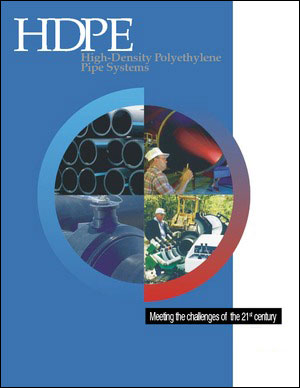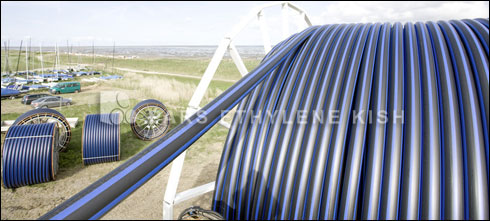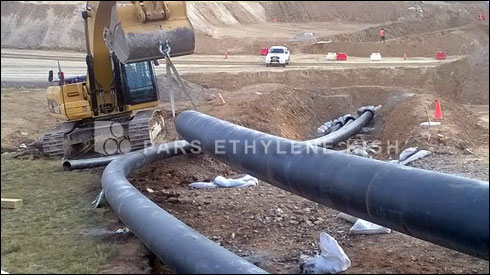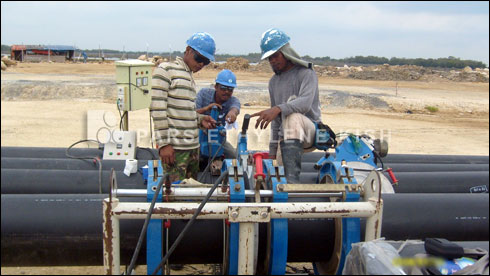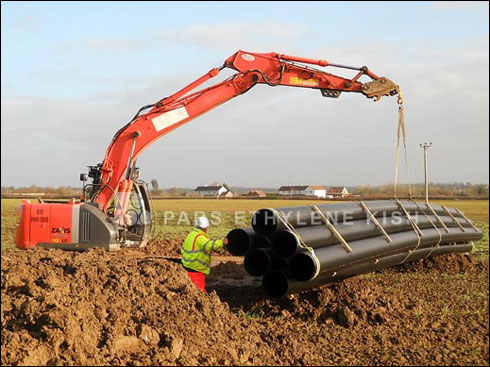
Handbook of PE Pipe
The handbooks of PE pipe were released by Plastic Pipe Institute as a guide for those seeking to use these pipes in the industry. In these handbooks, the advantages of PE pipes are highlighted and also tips for buyers of all types of PE pipes and all of their applications are mentioned to make the best choice at the most affordable price. In addition, the correct design, installation and various capabilities of Polyethylene pipes for use in a variety of applications are taught.
download the chapters of these handbooks
♦ Chapter 1 - Introduction : Since its discovery in 1933, PE has grown to become one of the world’s most widely used and recognized thermoplastic materials.(1) The versatility of this unique plastic material is demonstrated by the diversity of its use and applications. The original application for PE was as a substitute for rubber in electrical insulation during World War II. PE has since become one of the world’s most widely utilized thermoplastics. Today’s modern PE resins are highly engineered for much more rigorous applications such as pressure-rated gas and water pipe, landfill membranes, automotive fuel tanks and other demanding applications PE’s use as a piping material first occurred in the mid 1950’s. In North America, its original use was in industrial applications, followed by rural water and then oil field production where a flexible, tough and lightweight piping product was needed to fulfill the needs of a rapidly developing oil and gas production industry. The success of PE’s pipe in these installations quickly led to its use in natural gas distribution where a coilable, corrosion-free piping material could be fused in the field to assure a “leak-free” method of transporting natural gas to homes and businesses. PE’s success in this critical application has not gone without notice and today it is the material of choice for the natural gas distribution industry. Sources now estimate that nearly 95% of all new gas distribution pipe installations in North America that are 12” in diameter or smaller are PE piping.) Download Now
♦ Chapter 2 - Inspections, Tests and Safety Considerations : Once a PE piping system has been selected and designed for an application, the design is implemented by procuring the pipe, fittings and other necessary appurtenances, installing the system, and placing it in service. Piping installation involves people and machines in motion to move, assemble, install, inspect and test the piping system. Whenever moving machinery, piping parts, and personnel are engaged in piping system construction, safety must be a primary consideration. This chapter presents some of the inspections, tests and safety considerations related to installing PE piping, placing an installed system in service, and operating a PE piping system. Cautionary statements are provided in this chapter, but this chapter does not purport to address all of the product applications, inspections, tests, or construction practices that could be used, nor all of the safety practices necessary to protect persons and property. It is the responsibility of the users of this chapter, installers, inspectors and operators of piping systems to establish appropriate safety and health practices, and to determine the applicability of regulatory limitations before any use, installation, inspection, test or operation. Download Now
♦ Chapter 3 - Material Properties : A principal objective of the following brief review of the nature of polyethylene (PE) piping materials, of their physical and chemical properties, and of their mechanical and engineering behavior, is to impart a basic understanding of the factors that lie behind the discussions and recommendations contained in this Handbook for the proper storage, handling, installation, design and operation of PE piping systems. Also included in this Chapter is an Appendix that lists values for the more common engineering design properties of PE piping materials.Download Now
♦ Chapter 4 - PE Pipe and Fittings Manufacturing : The essential steps of PE pipe and fitting production are to heat, melt, mix and convey the raw material into a particular shape and hold that shape during the cooling process. This is necessary to produce solid wall and profile wall pipe as well as compression and injection molded fittings. All diameters of solid wall PE pipe are continuously extruded through an annular die. Whereas, for large diameter profile wall pipes, the profile is spirally wound onto a mandrel and heat-fusion sealed along the seams. Solid wall PE pipe is currently produced in sizes ranging from 1/2 inch to 63 inches in diameter. Spirally wound profile pipe may be made up to 10 feet in diameter or more. PE pipe, both the solid wall type and the profile wall type, are produced in accordance with the requirements of a variety of industry standards and specifications such as ASTM and AWWA. Likewise, the PE fittings that are used with solid wall PE pipe are also produced in accordance with applicable ASTM standards. Refer to Chapter 5 for a list of the commonly used PE pipe standards. Download Now
♦ Chapter 5 - Standard Specifications, Standard Test Methods and Codes for PE (Polyethylene) Piping Systems : The specification, design and use of PE piping systems is addressed by a number of standard specifications, standard test methods and codes including those issued by ASTM International (ASTM), American Water Works Association (AWWA), and Canadian Standards Association (CSA) as well as Technical Reports (TR’s) and Technical Notes (TN’s) published by the Plastics Pipe Institute (PPI). A listing of the more frequently referenced standards, reports and recommendations is presented in the Appendix to this Chapter. Download Now
♦ Chapter 6 - Design of PE Piping Systems : Design of a PE piping system is essentially no different than the design undertaken with any ductile and flexible piping material.The design equations and relationships are well-established in the literature, and they can be employed in concert with the distinct performance properties of this material to create a piping system which will provide very many years of durable and reliable service for the intended application. In the pages which follow, the basic design methods covering the use of PE pipe in a variety of applications are discussed. Download Now
♦ Chapter 7 - Underground Installation of PE Piping : Piping systems are prevalent throughout our everyday world. Most of us think of piping systems as underground structures used to convey liquids of one sort or another. To the novice, the concept of pipeline installation underground sounds relatively straight forward: a) dig a trench, b) lay the pipe in the trench, and c) fill the trench back in. While this simplified perspective of pipeline construction may be appealing, it does not begin to address the engineering concepts involved in the underground installation of a pipeline. This chapter is written to assist in the development of a comprehensive understanding of the engineering principles utilized in the underground installation of PE pipe. In the pages which follow, the reader will be introduced to the concept of a pipe soil system and the importance that the soil and the design and preparation of the back-fill materials play in the long-term performance of a buried pipe structure. Specific terminology and design concepts relating to the underground installation of PE pipe will be fully discussed. This will include fundamental guidelines regarding trench design and the placement and subsequent backfill of the PE pipe. Download Now
♦ Chapter 8 - Above-Ground Applications for PE Pipe : In above ground applications PE piping may be suspended or cradled in support structures or, it may simply be placed directly on the ground surface. These types of installations may be warranted by any one of several factors. One is the economic considerations of a temporary piping system. Another is the ease of inspection and maintenance. Still another is simply that prevailing local conditions and even the nature of the application itself may require that the pipe be installed above ground. PE pipe provides unique joint integrity, toughness, flexibility, and low weight. These factors combine to make its use practical for many “above-ground” applications. This resilient material has been used for temporary water lines, various types of bypass lines, dredge lines, mine tailings, and fines-disposal piping. PE pipe is used for slurry transport in many industries such as those that work with kaolins and phosphates. The ease of installation and exceptional toughness of PE pipe often make it practical for oil and gas collection. The economics and continued successful performance of this unique piping material is evident despite the extreme climatic conditions that may sometimes exist in some of these diverse applications. Download Now
♦ Chapter 9 - PE Pipe Joining Procedures : An integral part of any pipe system is the method used to join the system components. Proper engineering design of a system will take into consideration the type and effectiveness of the techniques used to join the piping components and appurtenances, as well as the durability of the resulting joints. The integrity and versatility of the joining techniques used for PE pipe allow the designer to take advantage of the performance benefits of PE in a wide variety of applications Download Now
♦ Chapter 10 - Marine Installations : Since the early 1960’s, just a few years after its first introduction, polyethylene (PE) piping has been increasingly used for various marine applications such as effluent outfalls, river and lake crossings, and fresh and salt-water intakes. Immunity to galvanic corrosion is a major reason for selecting PE. The combination of air and water, but particularly seawater, can be very corrosive to ordinary metallic piping materials. But other beneficial features, as follows, combine to make PE piping particularly well-suited for marine applications Download Now
♦ Chapter 11 - Pipeline Rehabilitation by Sliplining with PE Pipe : An integral part of the infrastructure is the vast network of pipelines, conduits, and culverts in North America. These are among the assets we take for granted, since most are buried and we never see them. We do not see them deteriorate either, but we know that they do. Television inspection of the interiors of these systems often reveals misaligned pipe segments, leaking joints, or other failing pipe integrity. Download Now
♦ Chapter 12 - Horizontal Directional Drilling : The Horizontal Directional Drilling (HDD) Industry has experienced so much growth in the past two decades that HDD has become commonplace as a method of installation. One source reported that the number of units in use increased by more than a hundredfold in the decade following 1984. This growth has been driven by the benefits offered to utility owners (such as the elimination of traffic disruption and minimal surface damage) and by the ingenuity of contractors in developing this technology. To date, HDD pipe engineering has focused on installation techniques, and rightfully so. In many cases, the pipe experiences its maximum lifetime loads during the pullback operation. Download Now
♦ Chapter 13 - HVAC Applications for PE Pipe : The performance and use characteristics of polyethylene pipe make it an ideal choice for use in certain HVAC – Heating, Ventilation, and Air Conditioning – applications. Typically, HVAC is thought of as flexible vent pipes, steam pipes, etc. However, since the 1980’s polyethylene pipe’s flexibility, strength, and ease of use has had a major impact on HVAC applications Download Now
♦ Chapter 14 - Duct and Conduit : The general purpose of conduit, or duct, is to provide a clear, protected pathway for a cable, or for smaller conduits, sometimes called innerducts. Advances in cable technologies, as well as the expense of repairing sensitive cable materials like fiber optic cable, have driven preferences for protective conduit over that of direct burial. Polyethylene (PE) conduit provides mechanical protection to fragile cable materials like fiber optic and coaxial cables, as well as protection from moisture or chemicals and even, in some cases, animals. Furthermore, the permanent pathway provided by conduit also facilitates replacement projects or future installations of additional cable or duct. Download Now
♦ Chapter 15 - General Guidelines for Repairing Buried PE Potable Water Pressure Pipes : Traditional piping systems have gasket-sealed bell and spigot joints every 20 feet, which can be a potential maintenance and repair point at each connection. Metallic pipes are subject to corrosion which can require constant maintenance over the life of the pipes. A heat fused high density polyethylene (PE) pipeline is not only corrosion and chemical resistant but the leak free joints at 40 to 50 foot intervals are as strong as the pipe itself which provides a maintenance free system except for infrequent unforeseen third party damage. If PE is damaged by a third party, repair methods may be required to bring the piping system back into service as soon as possible. This document will provide general guidelines for repairing PE. They should be useful in establishing procedures and/or specifications for various repair methods to PE piping systems. Download Now
♦ Chapter 16 - Pipe Bursting : Underground service utilities in many American cities have been in place for over 100 years. While existing systems have functioned well beyond reasonably anticipated service life, underground systems are mostly deteriorated and need costly maintenance and repair. Common problems involve corrosion and deterioration of pipe materials, failure or leakage of pipe joints, and reduction of flow due to mineral deposits and debris build up inside the pipe. Damage to existing pipes can also occur by ground movements due to adjacent construction activity, uneven settlement or other ground instability. This leads to infiltration and inflow (I&I) increase in sewer systems. In water systems, it leads to flow and pressure reductions, persistent leakage (up to 30 percent of water provided in some systems), pipe bursts, and poor water quality. These problems tend to increase with the age of the network where maintaining this large network of underground sewer, water, and gas pipelines is difficult and costly. The above problems are compounded by the significant negative impacts (of open cut repair or replacement projects) on the daily life, traffic, and commerce of the area served by and along the pipeline in question. Download Now
